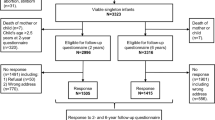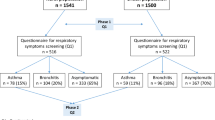Abstract
The Passaic Asthma Reduction Effort (PARÉ) used an asthma symptom and household exposure factor questionnaire to screen 4634 elementary school children over a 4-year period in Passaic, New Jersey. During the first year, an additional 240 preschool children were also screened. Overall, 16% of the school children were reported by their parents to have been diagnosed with asthma. In all, 30% of responding families claimed to have at least one family member diagnosed with asthma and this was five times more likely if the target child had asthma. Exposures consistently associated with childhood asthma diagnosis included environmental tobacco smoke (ETS), presence of dampness/mold, roaches, and furry pets in the home. Diagnosis of asthma was primarily associated with all six symptoms used in the PARÉ questionnaire, and secondarily with environmental factors. Puerto Rican and black children had the highest asthma prevalence (26% and 33%), while Mexican children had the lowest (7%). Use of medications and school absenteeism among asthmatic children were associated with wheeze and night cough, but not with any specific environmental exposure. Increased school absenteeism by children undiagnosed with asthma was associated with ETS and dampness/mold in the home. Differences in asthma diagnosis and absenteeism in response to environmental factors were found across ethnic subgroups. Getting asthmatic children on medical management protocols and providing families with education about environmental risk reduction should aid in reducing morbidity in this ethnically complex population. Such coordinated efforts offer the promise of reducing school absenteeism.
This is a preview of subscription content, access via your institution
Access options
Subscribe to this journal
Receive 6 print issues and online access
$259.00 per year
only $43.17 per issue
Buy this article
- Purchase on Springer Link
- Instant access to full article PDF
Prices may be subject to local taxes which are calculated during checkout
Similar content being viewed by others
Abbreviations
- CI:
-
confidence intervals
- df:
-
Degrees of freedom
- dx:
-
diagnosis
- ETS:
-
environmental tobacco smoke
- OR:
-
odds ratio
References
Altemeier W.A. Children with asthma: we can do better. Pediatr Ann 1996: 25: 124–125.
American Institute of Research. Wee Wheezers Asthma Education Program. 1991: 15 pp.
Asher M.I., et al. International Study of Asthma and Allergies in Childhood (ISAAC): rationale and methods. Eur Respir J 1995: 8: 483–491.
Beckett W.S., et al. Asthma among Puerto Rican Hispanics: a multi-ethnic comparison study of risk factors. Am J Respir Crit Care Med 1996: 154: 894–899.
Chilmoncyzk B.A., et al. Association between exposure to environmental tobacco smoke and exacerbations of asthma in children. N Engl J Med 1993: 328 (23):: 1665–1669.
Eskenazi B., et al. Exposures of children to organophosphate pesticides and their potential adverse health effects. Environ Health Perspect 1999: 107 (Suppl. 3): 409–419.
Finkelstein J.A., et al. Parent-reported environmental exposures and environmental control measures for children with asthma. Arch Pediatr Adolesc Med 2002: 156: 258–264.
Flores G., et al. The impact of ethnicity, family income, and parental education on children's health and use of health services. Am J Public Health 1999: 98: 1066–1071.
Fowler M.G., et al. School functioning of US children with asthma. Pediatrics 1992: 90: 939–944.
Freeman N.C.G., et al. School-based screening for asthma in third-grade urban children: results from the Passaic Asthma Reduction Effort. Am J Public Health 2002: 92: 45–46.
Ingram J.M., et al. Quantitative assessment of exposure to dog and cat allergens relating to sensitization and asthma among children. J Allergy Chem Immunol 1995: 96: 449–456.
Joseph C.L., et al. Sensitivity and specificity of asthma definitions and symptoms used in a survey of childhood asthma. J Asthma 1999: 36: 565–573.
Koren H.S. Environmental risk factors in atopic asthma. Int Arch Allergy Immunol 1997: 113: 65–68.
Lanphear B.P., et al. Residential exposures associated with asthma in US children. Pediatrics 2001: 107: 505–511.
Lieu T., et al. Racial/ethnic variation in asthma status and management practices among children in managed Medicaid. Pediatrics 2002: 109: 857–865.
Mendoza F., et al. Selected measures of health status for Mexican-American, mainland Puerto Rican, and Cuban-American children. JAMA 1991: 265: 227–232.
New York City Health and Hospitals Corp. Child Health Clinics. Asthma Screening Questionnaire. 1995: p. 1.
Platts-Mills T.A., Carter M.C. Asthma and indoor exposure to allergens. N Engl J Med 1997: 336: 1382–1384.
Rylander R., and Etzel R. Introduction and summary: workshop on children's health and indoor mold exposure. Environ Health Perspect 1999: 107 (Suppl. 3): 465–468.
Stoddard J.J., and Miller T. Impact of parental smoking on the prevalence of wheezing respiratory illness in children. Am J Epidemiol 1995: 141: 96–102.
Schneider D., et al. Respiratory dysfunction among a cohort of mostly Hispanic urban primary school children. 2003 (In review).
SPSS Inc. 2000. SPSS version 10.1, Chicago, IL.
U.S. Department of Commerce, Bureau of the Census. Census 2000 (American FactFinder). www.census.gov. Nov 2002.
Weiss K.B., et al. Inner City asthma: the epidemiology of an emerging U.S. public health concern. Chest 1992: 101: 3625–3675.
Acknowledgements
This project was funded by the Robert Wood Johnson Foundation–New Jersey Health Initiatives (RWJ/NJHI) and approved by Passaic Beth Israel Hospital and the Passaic Board of Education. We acknowledge the enormous effort the Passaic public and private school systems put into this project, thank the RWJF/NJHI and the members of the Passaic Advisory Council, St. Mary's Hospital, The Passaic Board of Education, the Passaic Parochial Schools, Yeshiva K'tana, Passaic Prep School, Guidance Guild, Children's Day Nursery, Our Lady of Fatima Day Care, New Bairn School, Passaic Head Start, Passaic Health Department, Hispanic Information Center, Rutgers University School of Urban Studies and Community Health, Felician College Department of Professional Nursing, Ellen Ziff, Erik and Lisha Ramos, and the project interns, Carrie Bogert and Lenora Roth.
Author information
Authors and Affiliations
Corresponding author
Rights and permissions
About this article
Cite this article
Freeman, N., Schneider, D. & McGarvey, P. Household exposure factors, asthma, and school absenteeism in a predominantly Hispanic community. J Expo Sci Environ Epidemiol 13, 169–176 (2003). https://doi.org/10.1038/sj.jea.7500266
Received:
Accepted:
Published:
Issue Date:
DOI: https://doi.org/10.1038/sj.jea.7500266
Keywords
This article is cited by
-
Deep learning-based school attendance prediction for autistic students
Scientific Reports (2022)
-
Indoor air pollution from biomass fuels: a major health hazard in developing countries
Journal of Public Health (2012)



